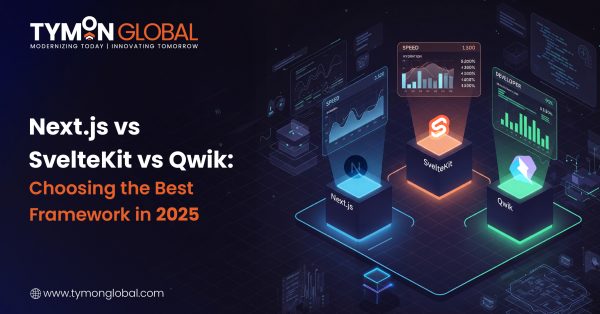
In modern web development, framework selection involves architecture, scalability, and interpretation. Due to the many alternatives, choosing a framework for your next app may be tough. JavaScript frameworks 2025 have several uses, including React, Vue, Svelte, and Angular. Next.js, Astro, Remix, Gatsby, Nuxt, SvelteKit, and Qwik are similar meta-frameworks with their unique benefits.
In this blog, we’ll compare three of the most talked-about best frontend frameworks in web development today: Next.js, SvelteKit, and Qwik. Many frameworks optimize performance, produce static sites, and support SSR. Before deciding, developers should weigh each framework’s merits and cons. The top 2025 web development framework and its effects on developer experience, scalability, and performance will be discussed.
Why Choosing the Right Framework Matters in 2025
Clients would expect faster load times and more even cross-device interactions from the right and best web framework in 2025. Team productivity and market speed require developer experience. Your framework must operate with the tools and technologies that enable your application and match your business goals. The primary project framework considerations are listed below:
- SvelteKit performance loads 50% quicker than React-based frameworks, and Qwik is 10x faster without JavaScript.
- Qwik excels in performance-driven scalability, while Next.js excels at full-stack projects.
- Next, Qwik prioritizes performance, SvelteKit is simple, and JS has a strong ecosystem.
- Next.js has 500k+ developers, SvelteKit is 150% growing, and Qwik grew 5x in 2023.
- Qwik’s zero initial JavaScript payload boosts SEO by 50%, but Next.js and SvelteKit have high SSR/SSG.
Qwik, Next.js, and SvelteKit are popular web app builders with benefits and cons. Comparing performance, scalability, development expertise, andcommunity support can help you select.
Before we go over how these two frameworks compare, let’s take a quick look at each individually.
What is Next.js?
Next.js, a React-based framework, allows programmers to construct both static and server-side rendered (SSR) web apps. Performance and SEO are improved via incremental static regeneration (ISR), API routes, and static site generation (SSG).
What is SvelteKit?
SvelteKit is a fast online application framework based on Svelte. It has server-side rendering (SSR), static site generation (SSG), and basic routing to make things faster by turning components into fast JavaScript.
What is Qwik?
Qwik is a sophisticated framework that enables speedy and lazy loading with high accuracy. It lowers the page’s first JavaScript load, which speeds up generating, creating web programs fast and usefully.
Comparison of Next.js, SvelteKit, and Qwik in 2025
In 2025, it will be vital to use the right framework to develop apps that run well and can grow. To assist you in choosing the best one for your web development needs, here is a comparison of Next.js, SvelteKit, and Qwik:
| Feature | Next.js | SvelteKit |
Qwik |
| Primary Focus | Full-stack React, SSR, SSG, API routes. | Cloud-native, SSG, SSR, minimal configuration. | Performance-first, zero JavaScript on initial load. |
| Rendering | SSR, SSG, ISR. | SSR, SSG, Static Pre-rendering. | Fine-grained lazy loading, zero initial JavaScript. |
| Performance | Solid, but larger apps can increase bundle size. | 50% faster load times than React-based apps. | 10x faster initial render with zero payload. |
| Bundle Size | Larger, optimized with dynamic imports. | Small, optimized to vanilla JS (typically 50KB). | Extremely small, under 10KB for many apps. |
| Developer Experience | Mature, with 200% growth in adoption. | Simple syntax, fast dev cycles, 150% growth. | Focuses on performance, growing rapidly by 5x. |
| API Integration | Strong API route support. | Easy integration with APIs. | Excellent for API integration with zero initial JS. |
| State Management | Uses Redux or Context API. | Native reactive state management. | Fine-grained reactive state, fast updates. |
| Community Support | 500k+ developers, very active. | 50k+ stars on GitHub, growing quickly. | Rapidly growing, with a 400% increase in 2023. |
| SEO | Excellent for SEO with SSR and SSG. | Great SEO with SSG and SSR. | 50% better SEO crawl rates due to zero initial JavaScript. |
| Popularity | Powers 4.5M+ websites, 1M active developers. | Increasing adoption is used in startups and apps. | Gaining traction, early adoption growing 5x. |
Why is Tymon Global the Right Choice for Scalable Web Solutions?
When choosing between Next.js, SvelteKit, and Qwik, consider that the framework satisfies your business requirements, technical specifications, and scalability goals. Working with a leading IT service provider partner like Tymon Global guarantees that you select the best framework for your company, even though each of these frameworks offers unique benefits.
A leading supplier of digital product engineering services, Tymon Global focuses on assisting companies in overcoming the challenges associated with contemporary web development. Our team of professionals will help you choose the best framework, best API integration solutions, and guarantee a smooth implementation.
Tymon Global is dedicated to helping you with efficient scalability, particularly if you are switching from traditional systems to microservices. Our experience in application development services will guarantee that your project works smoothly from beginning to end.
Make the Right Choice for 2025 with Tymon Global
The framework determines the scalability and performance of your 2025 web app. Next.js, Qwik, or SvelteKit—which can assist you in reaching 2025 business goals? SvelteKit and Qwik are fast, while Next.js is excellent for full-stack enterprise projects. Business framework selection should go beyond performance and scalability. Consider API creation, implementation, and integration ease. Tymon Global helps you choose and install SvelteKit, Next.js, or Qwik.
Get in touch with Tymon Global today to explore how we can help you choose and integrate the best frameworks and API solutions for your web applications in 2025.
Frequently Asked Questions
Q. Which framework is best for SEO in 2025: Next.js, SvelteKit, or Qwik?
For SEO in 2025, Next.js offers excellent server-side rendering (SSR) and static site generation (SSG), making it ideal for dynamic content and better search engine crawlability. SvelteKit also excels in SEO with SSG and SSR. Qwik boosts SEO performance by offering 50% better crawl rates with zero initial JavaScript.
Q. How does Next.js improve SEO for modern web apps?
Next.js improves SEO with SSR and SSG, allowing search engines to index pages more effectively, leading to better rankings. The Incremental Static Regeneration (ISR) feature ensures that content remains fresh while maintaining excellent SEO performance.
Q. What makes SvelteKit the best framework for fast web apps?
SvelteKit compiles code into highly optimized vanilla JavaScript, resulting in faster load times and smaller bundle sizes. It’s 50% faster than React-based frameworks and ideal for developers aiming to build lightweight, performance-driven apps.
Q. Is Qwik the fastest web framework for 2025?
Yes, Qwik is built with performance-first principles and provides 10x faster initial rendering by loading only the necessary JavaScript. Its zero initial JavaScript payload ensures faster load times, making it one of the most efficient frameworks for performance in 2025.
Q. How does Qwik handle scalability for large applications?
Qwik prioritizes fine-grained lazy loading, which ensures that only the needed code is loaded for visible parts of the page. This makes it highly scalable for large applications that need fast performance and minimal initial load times, ensuring optimal user experience even in high-traffic situations.

